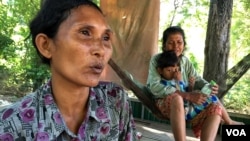In November last year, Long Thon was sitting in her village with her neighbors talking about their farms, which have been severely affected by the recent drought – the worst in Cambodia for several decades.
She has suspended working on her rice field in Kandal province since November last year due to the drought.
On Friday last week Thon was taking a nap, exhausted by the heat. She said she was happy because it was raining on Wednesday night. She said it was the first rain since November last year. During the rainy season last year Thon, whose family lives in Ponhea Leu district, Vihear Luong commune, which is about 40 kilometers from Phnom Penh, could not farm given that there was not enough water.
Her family, which used to live off the three acres of land she farms, now has to rely on her daughters, who are garment workers.
“There has been no rain, since you came to interview me [last year] till now that you returned,” she said, adding that she spends about $8 each week on water, a large sum for a family used to living off the land.
Thon’s story is not unique. Millions of Cambodians rely on the rains to feed their farms and use for the daily running of their households. According to the Ministry of Agriculture, three-quarters of Cambodians still rely on farming for their main source of income.
“We need water for drinking, laundry and also to wash ourselves,” she said.
“Everyone is like everyone else. Vegetable and trees are dying [because there is no water], there is nothing left,” she said.
In Kampong Thom province about 70 tons of fish died in the Tonle Chhmar river in April due to the hot weather and drought, according to the Stoung district governor, Prim Rotha.
In Battambang province, about 30 black monkeys died because they did not have enough water, food and shelter after they managed to escape a fire the month before, according to a community representative.
Some scientists have blamed the “El Niño” phenomenon for the heat wave and drought.
“In Southeast Asia this heat wave joins the historical ones of 1960, 1983 and 1998, but as for duration, intensity and affected area it is definitely the strongest heat wave for Thailand, Laos and Cambodia,” Maximiliano Herrera, a prominent climatologist who investigates world temperature records, told VOA.
The government has taken some steps to address the crisis, including instructing schools to shorten the teaching day by one hour and by telling local authorities to dig wells and mobile water facilities for villagers.
Keo Vy, cabinet director at the National Committee for Disaster Management, said that this year Cambodia was likely to experience heavy drought until July.
“Though the metrology shows that there could be some rain, there won’t be standing water because of the hot whether … the rain will be absorbed [by the soil], so there won’t be standing water,” he said.
“In 2004 we experienced drought in 21 provinces, but the situation was not as bad as it is now... people are deprived of water because there is no water in the wells as the water is dried out,” he said.
Trean Chung, 29, a farmer in Tbong Khmum’s Dambe district, said many farmers in the area had dug wells but were unable to draw water from them since the start of the drought.
“Many people do not have water. Some of those who raise pigs need a lot of water per day,” said Chung. “We did not have water for three months. Those people, who do not have access to water, have kept buying water for three months already,” he said.
“For farmers like me, we are waiting for rain to come, so we could plant cassava. If there is no rain, we will have to wait,” he added. “I do not have another job. I rely wholly on farming.”
Tek Vannara, director of the NGO Forum, told VOA that the development of heavy industry, deforestation and large-scale development projects were partly to blame.
“For the long term people could collect and store the rain for the coming year as much as they could, so they could use the water when they are short of water,” he said, adding that he would encourage people to have more ponds and canals around their houses to store water.
“For the government and local authority, they should set a clear plan to restore canals, dams, and irrigation, in order to store water to use in the dry season,” he said.
Vannara added that the government had to provide people new seeds that could stand the heat, and provide technical and other agriculture materials to them to mitigate the situation. He insisted that the government should plant more trees and protect the last remaining forests.
Keo Vy acknowledged that the Cambodian government could not stop climate change from happening, so helping people to adapt to this dilemma is a must.
“We cannot solve the problem from climate change. But we could have our people adjust to climate change,” he said.
“We could change from growing heavy rice to light rice as experts with the Ministry of Agriculture advise us. We call it adjusting to climate change, so that the farmer could adapt to climate change without jeopardizing their crops,” he said.
Nget Lat, chief of Vihear Luong commune’s Ampil Pa’em village, said that the price of digging wells was prohibitively expensive for most farming communities.
“The well cost depends on the size. One kind of well costs more than $200 and another kind costs more than $1,000. They [villagers] could not afford that.”







